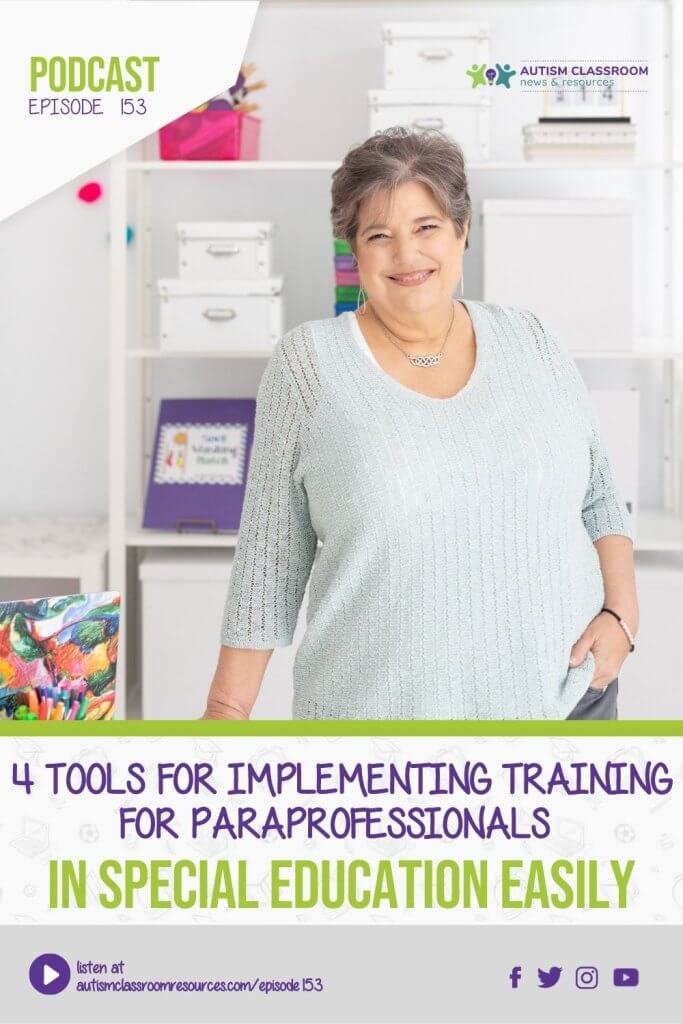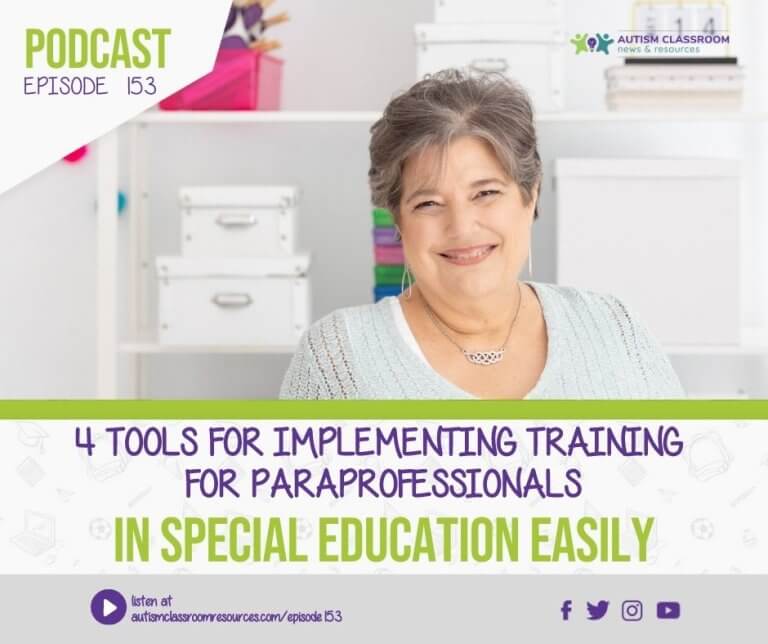Welcome to the Autism Classroom Resources Podcast, the podcast for special educators who are looking for personal and professional development.
Christine Reeve: I’m your host, Dr. Christine Reeve. For more than 20 years, I’ve worn lots of hats in special education but my real love is helping special educators like you. This podcast will give you tips and ways to implement research-based practices in a practical way in your classroom to make your job easier and more effective.
Welcome back to the Autism Classroom Resources podcast. I am so happy you’re here. I am Chris Reeve, and I’m your host.
And we have been talking about the CORE model, the classroom organization results in efficiency model and the structures it puts in place. And recently, we’ve been talking about how that integrates with training staff in the special education classroom.
So last week, I talked about some strategies to make training work in the classroom, and about training, you know, training paras and other aides in the classroom is definitely a very difficult part of special educators’ jobs.
So I talked about how training fits into your day and how you can make it work in the classroom in Episode 152. So if you want to listen to that, you can definitely find it at autismclassroomresources.com/episode 152.
In today’s episode, I want to give you some resources that you can use for training paraprofessionals in the classroom. So many of these are going to be strategies or tools that you would use for getting the background information to give them an overall view of why the strategy is important, an overview of how it works, when you would use it, why you would use it. So they’ve got the why and then you can focus your more direct training, through video modeling and other things that I talked about last week, on the how.
So I’m also going to give you some places where you can download tools that can also be helpful for you in terms of connecting your staff with the tools or tools that you can use in your training process. So let’s get started.
The first one that I want to talk about are our three free webinars that I have in the free resource library, they are available to anyone on staff. So staff member can also get a certificate of completion when they have completed it. All of them are a little less than an hour. And you can find them at the link in the show notes. And also, I’ll make sure that the link is in the post for this episode at autismclassroomresources.com/episode 153.
Just to give you a brief overview of the webinars, there’s one on implementing independent work systems that I think is a really good match for teachers who have not used them because it talks about how we set them up and the important components. But it’s also really good for paraprofessionals to have an understanding about why they are doing it and what it involves.
So it’s going to give them a good overview of what independent work is all about, as well as the nuts and bolts of how to set it up well. I do recommend that if you send them to these webinars, that you participate in them as well if you haven’t already, because that’s going to make sure that you’re both getting the same information. And I don’t want to have them hear something from me that contradicts something that you do. Although most of the things I talk about a best practice so that shouldn’t be the case.
Now, if you’re expecting them to follow through with behavioral support, then there is a webinar on preventing challenging behavior in the classroom. Again, I think that’s a really good choice for paraprofessionals. Because typically, they are dealing with challenging behavior in our classrooms and with our students, and it walks through some antecedent based strategies and tools to explain why we use things like visuals, and why we structure the room the way that we do and things like that, to give them again, some background information to know where you’re coming from.
And sometimes it’s just helpful for them to hear it from somebody else. Sometimes you’ve heard the same thing over and over and it sounds new coming from a person that you don’t know. And because they’re watching me on the internet, you know, they may think this is an expert that’s telling us what to do.
So I talked last week, I gave an example of when this happened to me. That I had a consultant come into a program I was running and people just hung on his every word when he was saying exactly the same things I’ve been saying. So these probably do overlap with some of the things that you are saying. But the key element is sometimes it’s useful just to hear it from another source.
And as the consultant said to me, that’s because I’m special because I flew in on an airplane. He recognized that this was stuff that I had been saying. He understood that whole thing. And so he, I have ended up using that same phrase in my consulting, when people would say, “Oh, my gosh, I can’t believe that you just said that. I’ve been saying it over and over.” I’m like, It’s not you. It’s not that you’re not doing it right or saying it right is that I’m a different person than they heard me and I special because I flew an airplane.
So the next option or tool that might be useful for you, in addition to those webinars, are getting some overall understanding about your classroom and your strategies is to have them complete the Affirm Modules.
Now, the affirm modules will take a little bit more time for them to go through because there are specific, they are actually courses that our setup, but you can pick and choose what pieces you want them to pay attention to as well, and not require them to do the whole thing.
But these might be really good tools and videos to use for when there’s a paraprofessional development day, and you’re in training, and there’s no students and your staff is actually there. Or the student that they work with, if they’re one to one isn’t here today, this might be a good tool to pull out for that. Because they are a little bit longer and a little bit more didactic, they can be really useful for background information but there’s also some demonstrations of strategies and they are all based on evidence based practices.
Now they are quote, autism specific, but I will tell you that the strategies that we use for autism are really not that different than good practice that we use with all of our special ed students. So don’t let that trip you up. And I will make sure that the link to the Affirm Modules is also included in the notes for this episode.
Now, there are two ways that the Affirm Modules can actually be helpful. One is by providing the videos and the coursework for the staff to watch. The other is, I talked in Episode 152 about competency checklists and how I wouldn’t use them as a supervising tool but they can be a very useful training tool.
They have competency checklists in the courses for the evidence based strategies. And that can be really useful for helping you to break the training down to give them just one step at a time rather than trying to train them with a firehose, which was a tip I had in last week’s as well. And it also gives you an objective set of criteria that you’re looking for, that you can use to observe and give feedback and discuss. So they can be a really nice tool to have and that way, you don’t have to recreate them.
The next tool on the list is the IRIS Center at Vanderbilt Peabody education department at Vanderbilt University. They have tons of videos, exercises, and print tools for training on all different kinds of topics, from collaboration to assistive technology, to learning strategies. They have a new one out on including students in secondary grades that I think is worth a look for those of you who are supervising staff in that situation.
These are, again, longer resources, but there are individual pieces that you could pull out and just use those. So you could just pull the exercises out or the videos out or use the tools that they have as part of their exercises, and use them with observations in your own classroom.
So for instance, they have a module on taking partial interval data. And they you watch two students and you take data and then you discuss it. This is something that you could pull those tools and that strategy out and have them do it with students in your classroom. So they’re useful in that way. They’re also aligned with evidence based practices. And they’re aligned with CEC’s highly leveraged practices, so that can be a really nice dovetail.
In addition, next tool up, there are 30 behavioral videos, each are about less than five minutes, usually about two to two and a half minutes, in my free resource library.
So they all cover behavior strategies that we use in our classroom, antecedent strategies, replacement behavior strategies, and responsive strategies. They’re very quick and they are going to give staff an overview of why and how we use them.
So for instance, there’s a quick video on what is behavioral momentum. So I walk through what behavioral momentum is, what it looks like, why we would use it, and when we would use it. So those can be really helpful.
You can join the free resource library, and you’ll get a weekly email from me with tips and tools that you can use in your classroom. And you can also use those videos to share with your staff and they can join and watch there as well.
Finally, if you are a member of the Special Educator Academy, we have a whole section of training resources, some of which are designed so that you can download them to share them with your staff. So they include videos on how to take data with specific data sheets, how to implement independent work, how to redirect effectively, how to use a first then board, and more.
So some of those are videos in our training section that are 15 minutes or less, that are designed specifically for staff training. But we also have what we call lightning trainings that are just five minute videos that you can download with your loyalty points that you earn each time your membership renews. And those can be really good to share with your staff.
So hopefully this gives you some strategies and tools to pull from when you’re training staff in the classroom. I would love to hear about any tools that you’re aware of that are out there that I haven’t found yet, so come share them in our free Facebook group at specialeducatorsconnection.com.
Grab your free downloads from the resource library in the post for this episode at autismclassroomresources.com/episode 153. And make sure to come back next week when I will be talking about how we can tweak the CORE model and our CORE model strategies to accommodate for staff absences.
Until then have an amazing week!








